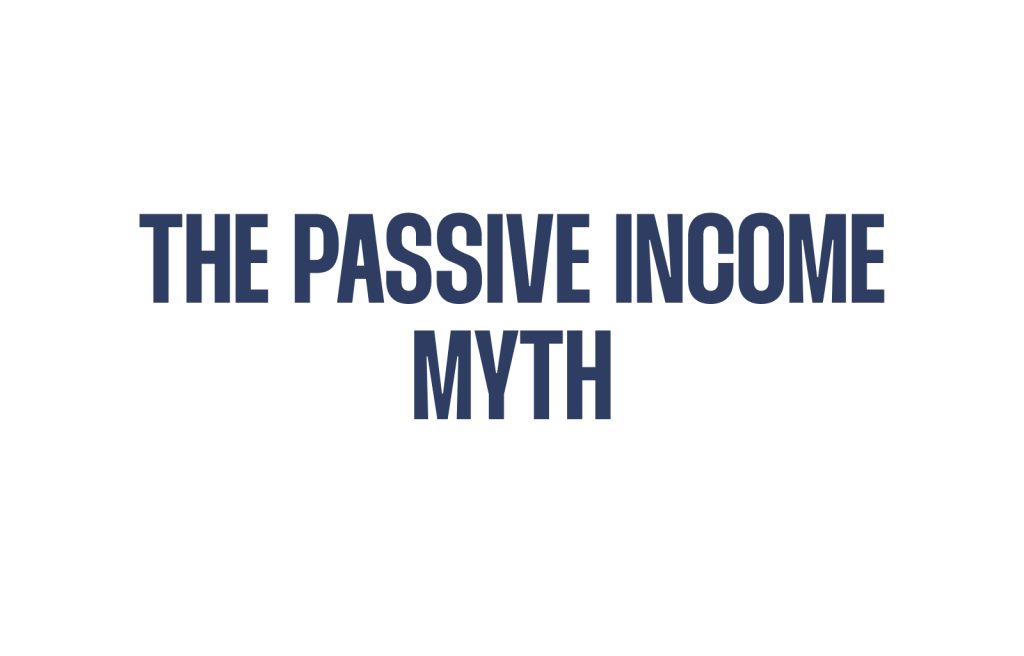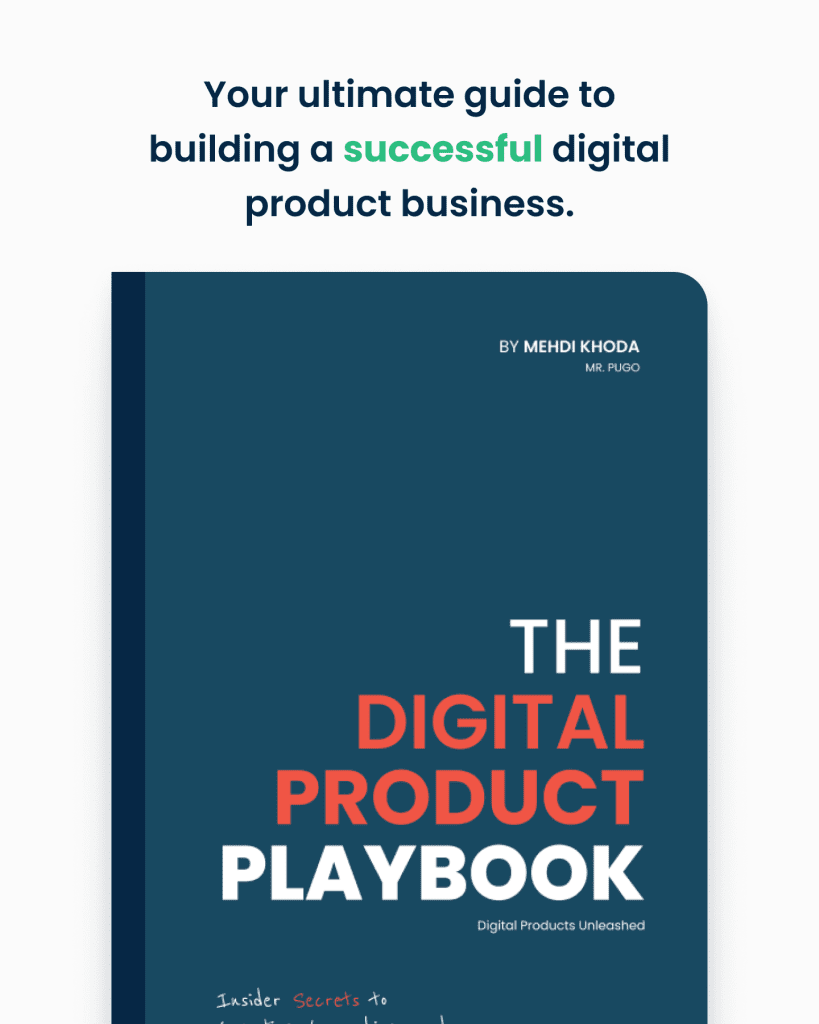The Passive Income Myth

The Truth About Passive Income: Debunking Myths and Setting Realistic Expectations
I’m sure you’ve heard the hype about how you can create an information product or program that you can sell online. That you can create something once and poof – the money will start rolling in (even while you sleep)!
In today’s fast-paced business world, passive income has become the Holy Grail for many entrepreneurs. The allure of making money without ongoing effort is undeniably appealing. However, it’s time to separate fact from fiction and gain a realistic understanding of what passive income truly entails.
Let’s debunk the passive income myth outright: truly passive income doesn’t exist. Passive income is a term that is loosely thrown around to define a revenue stream that takes little to no effort to manage. Many people agree that passive income can describe real estate pursuits, peer-to-peer (P2P) lending, and sometimes dividend stocks. But really, what is it? Who wouldn’t want passive income? The ability to be your own boss, work from home, choose your own hours—it’s all very enticing.
The myth of passive income is that you create something once and then sell it many, many times over. The “passive” part is that you can set things up once and then let it make money for you. But too often, things that are considered passive income are more of a misnomer than financial gurus would have you believe. In reality, many of the endeavors that get described as passive—like real estate, book royalties, or online sales—require a lot more work and consistent effort than the word “passive” suggests.
Let’s uncover the truth about passive income and understand what it really means. To get some definitions out of the way, passive income is theoretically what it sounds like: Money that flows into your back account with little to no ongoing effort on your part. Compared to the active labor of going to your day job, the idea with passive income is to build a system that automatically earns you money. However, the upfront time, effort, and money required to set up such a system is not exactly a passive pursuit. What’s more, most examples cited as passive income could be more accurately described as “side hustles,” since they typically require some sort of hustle to get them off the ground and to keep them running.
The truth…
The truth is that passive income requires a level of ongoing dedication and effort. There are no jobs that pay in this world without requiring any work. Even my cable company client, which appeared to be earning passive income, had its share of challenges and continuous maintenance requirements. No business truly runs itself, and most money-making endeavors take research, expertise, time, and money to make them worthwhile.
Passive income can be an amazing addition to your business, but you need to go in with your eyes wide open and know exactly what’s involved. Understanding all the steps that go into it now will save you time and heartache later, as you can put a realistic, long-term plan in place to make passive income work for you and your business.
So, is passive income real? Well, it depends on how you define it. While true passive income, where money flows in with minimal effort, may be elusive, there are opportunities to create semi-passive revenue streams. These revenue streams require upfront preparation, continuous improvement, and ongoing engagement, but they can provide a level of flexibility and financial freedom.
In online business circles, passive income is the proverbial brass ring. And the hype about creating passive income has reached epic proportions. Like any myth, things get twisted or lost along the way. Let’s debunk some of the common myths surrounding passive income and set realistic expectations.
Defining Passive Income
Passive income is often associated with revenue streams that require little ongoing effort to manage. Examples commonly cited include real estate investments, peer-to-peer lending, and dividend stocks. However, the term itself can be misleading. The activities that are typically labeled as passive income actually require a fair amount of work and consistent effort to make them worthwhile. They are better categorized as “semi-passive” or “leveraged” income streams.
Passivity: A Mythical State
In reality, no business truly runs itself. Even the seemingly perfect examples of passive income, like the cable company with tens of thousands of customers, involve ongoing challenges and responsibilities. Contracts must be negotiated, employees managed, and changes in technology and competition addressed. There’s no sitting back and collecting checks without actively tending to the business.
Passive Income: A Misnomer
Passive income encompasses various income sources, including interest, dividends, royalties, rents, and more. However, all of these sources require attention and effort to ensure their sustained success. Investors must actively monitor their investments to minimize risks. Authors and artists need to produce new works to stay relevant. Property owners must handle repairs, regulations, and tenant management. The reality is that passive income is far from passive—it requires ongoing work and attention.
The Illusion of Passivity
Many envision passive income as the ultimate goal—a life of leisure and financial abundance without the need for active involvement. However, the truth is quite different. In the 21st century, most businesses require active participation and continuous effort. Owners of restaurants, shops, and service-based companies are constantly searching for new opportunities, managing finances, and striving to attract and retain customers. Sitting back and collecting checks without any work is an illusion that rarely aligns with reality.
The Worth of Passive Income
While true passive income may be elusive, that doesn’t mean pursuing semi-passive income streams isn’t worthwhile. Building sustainable and leveraged income sources can provide financial stability and flexibility. However, it’s essential to understand that these endeavors still require work and dedication. The key is finding a balance between active and semi-passive income streams that align with your goals and aspirations.
Redefining Passive Income
Passive income is not a magical state of financial bliss. It’s a combination of smart investments, strategic business choices, and ongoing effort. It’s worth pursuing, but it’s crucial to dispel the myth of passivity. True financial success comes from actively participating in income-generating activities, continually learning and adapting, and finding fulfillment in the journey itself.
So, is passive income worth it? Absolutely. But let’s redefine our understanding of it and acknowledge that it’s still work. Embrace the idea of creating sustainable and leveraged income streams that provide financial stability while allowing for personal and professional growth.
Myth #1: Set it and Forget it
One common misconception is that passive income requires minimal effort and can run on autopilot once it’s set up. However, the reality is quite different. Take the example of running an online program. While it’s true that you can leverage technology to automate certain aspects, delivering a high-quality program that truly supports your students requires continuous effort and improvement.
Successful online programs go beyond providing information; they require personalized support, accountability, and a genuine commitment to helping your students achieve their goals. Passive income doesn’t mean sitting back and watching the money roll in—it requires ongoing engagement and a dedication to delivering value.
Myth #2: Quick and Easy Creation
Another myth is the idea that creating a passive income stream is as simple as throwing together a product or program in a couple of days. In reality, building something of quality takes time, research, and refinement. It’s not just about putting together content; it’s about understanding your audience, honing your expertise, and consistently delivering results.
Creating a successful online program involves laying the groundwork months or even years in advance. You need to invest time in understanding your audience’s needs, refining your content, and gathering feedback from previous iterations of your program. It’s an ongoing process of improvement and adaptation.
Myth #3: Anyone Can Do it
The notion that anyone can become a successful teacher or mentor without significant experience or expertise is a dangerous myth. While inspiring rags-to-riches stories exist, they often overlook the hard work, struggle, and lucky breaks that contributed to their success. For your program to truly succeed, it must deliver outstanding results for your students.
Being a great teacher requires more than just regurgitating information. It requires mastery, which comes from years of working with real people, gaining insights, and refining your approach. Your students’ success should be the ultimate measure of your teaching abilities.
Passive income can be an amazing addition to your business, but you need to approach it with realistic expectations. Understand that it requires ongoing effort, continuous improvement, and a genuine commitment to delivering value. Embrace the process, put in the necessary time and energy, and be prepared to adapt as you learn and grow.
Remember, success lies not just in the financial rewards but in the impact you create. Focus on building sustainable income streams that prioritize serving your audience and helping them achieve their goals. Passive income is not a myth, but it’s far from a shortcut to overnight success. With the right mindset, dedication, and hard work, you can create semi-passive revenue streams that provide both financial stability and personal fulfillment.
What are your thoughts on passive income? Do you agree that it’s a myth? Share your perspective in the comments below!
Keep Reading:
The Ultimate Guide: How to Make Money Online
110 Creative Ways Make money with ChatGPT
Unlocking Success: “The Digital Product Playbook” – Your Guide to Creating and Selling Digital Products
Ah, dear solopreneurs, we have a special treat for you! While we navigate the treacherous waters of self-promotion, it would be remiss not to mention an invaluable resource that could transform your one-person business into a digital product empire. Introducing “The Digital Product Playbook” by Mr. Pugo. This gem of a book contains secrets, strategies, and a pinch of wit to help you navigate the world of digital product creation and sales. So, if you’re ready to take your business to the next level and turn your expertise into lucrative digital products, grab a copy of “The Digital Product Playbook” today! Warning: Side effects may include uncontrollable laughter and unprecedented success.


















